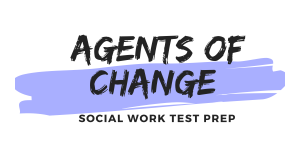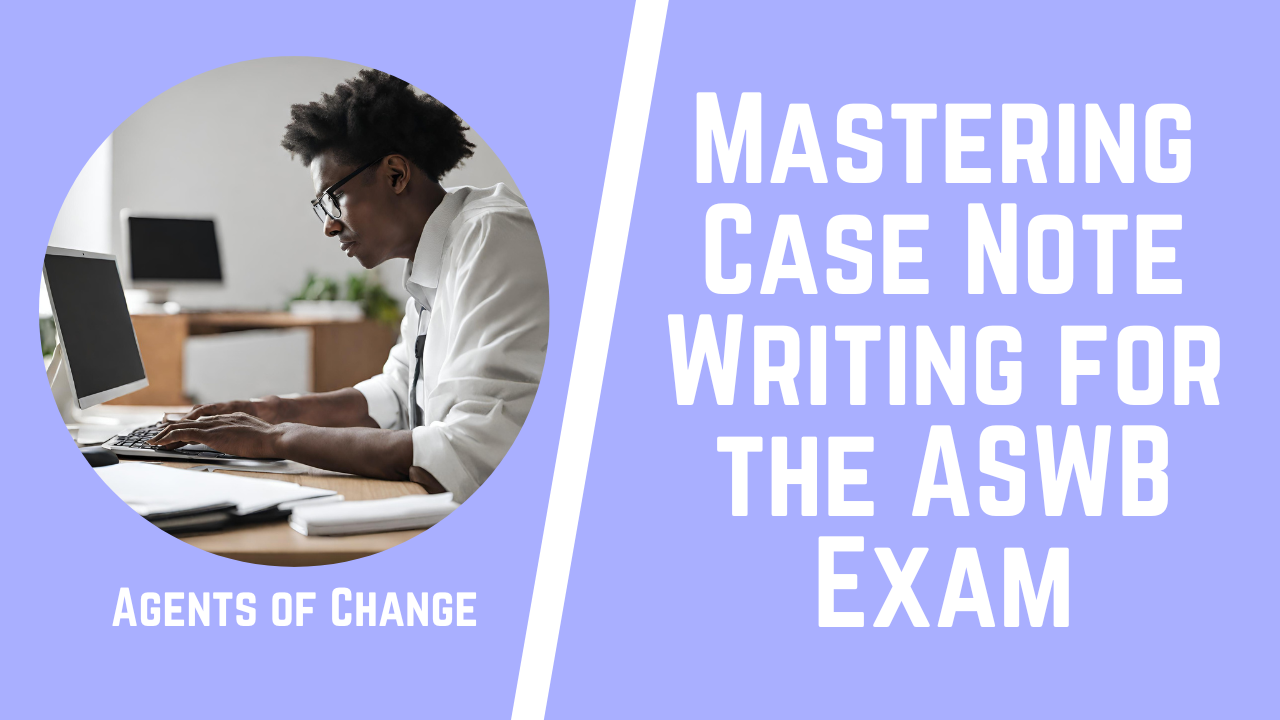Welcome to the world of Social Work, where the pen is mightier than you might think! For aspiring Social Workers preparing for the ASWB exam, mastering effective case note writing is not just about passing a test—it’s about laying the groundwork for a successful and impactful career.
This blog post is designed to transform you into a pro at documenting client interactions with clarity and precision. Whether you’re a student, a new practitioner, or a seasoned professional brushing up on your skills, you’ll find valuable insights and practical advice right here.
Effective case note writing serves multiple critical functions in Social Work. It ensures accurate record-keeping for continuity of care, aids in legal compliance, facilitates communication among care providers, and supports professional accountability and development. Given its significance, this skill must be approached with seriousness and strategy. This guide will dive into what makes a case note truly effective, discussing everything from the essential components to the common pitfalls to avoid.
Learn more about the ASWB exam and create a personalized ASWB study plan with Agents of Change. We’ve helped thousands of Social Workers pass their ASWB exams and want to help you be next!
1) The Role of Effective Case Note Writing in Social Work
Effective case note writing is a cornerstone of professional Social Work practice. As Social Workers, the ability to document client interactions clearly and comprehensively is crucial.
These notes serve as a legal record and an essential communication tool among care providers and a reference for future interactions.
Ensuring Continuity of Care
The continuity of care is critical in Social Work, where client interactions may span months or even years, with multiple interventions or changes in strategy. Effective case notes ensure that any practitioner can understand a client’s history and current needs without ambiguity. Here are some ways case notes support continuity:
- Tracking Progress: Documenting each session’s outcomes allows practitioners to see trends and patterns over time.
- Identifying Changes: Notes can highlight shifts in the client’s situation or response to intervention, prompting timely adjustments in the care plan.
- Facilitating Handovers: When a case is transferred to another social worker, comprehensive notes provide a seamless transition, ensuring the client does not suffer from service disruptions.
Enhancing Communication Among Team Members
In multidisciplinary settings, Social Workers often collaborate with other professionals such as doctors, nurses, psychologists, and legal advisors. Effective case notes act as a critical communication tool that provides everyone with the most current and relevant information about a client’s status.
- Sharing Insights: Case notes provide insights into a client’s emotional, psychological, and social state, which are useful for other professionals involved in their care.
- Avoiding Redundancies: Detailed notes prevent different team members’ repetition of assessments or treatments.
- Coordinating Efforts: They help synchronize the efforts of different professionals, ensuring that all interventions are aligned and mutually supportive.
Supporting Legal and Ethical Compliance
Social Work is bound by strict legal and ethical standards, and case notes often play a role in ensuring that these standards are met. Good documentation helps protect both the client and the Social Worker legally and ethically. Consider the following:
- Legal Evidence: In legal situations, case notes can be called upon as a record of the Social Worker’s interactions with the client.
- Ethical Practice: Proper documentation supports ethical practice by ensuring transparency and accountability in client interactions.
- Regulatory Requirements: Many jurisdictions have specific regulations governing the documentation of Social Work practices, and case notes must comply with these standards.
Facilitating Professional Development and Supervision
Case notes are not only about clients; they also serve as a tool for Social Workers’ personal and professional development. Supervisors and colleagues can review case notes to provide feedback, ensuring ongoing learning and improvement in practice. Here’s how case notes help:
- Reflective Practice: Reviewing one’s case notes can help Social Workers reflect on their practice and identify areas for growth.
- Supervisory Oversight: Case notes allow supervisors to oversee the work of Social Workers, providing guidance and ensuring quality of care.
- Training Tool: For new Social Workers, well-written case notes serve as examples of how to document client interactions effectively.
Effective case note writing is an essential skill that supports the critical functions of Social Work. By providing a reliable record of interactions, informing team communication, ensuring compliance, and facilitating professional growth, well-crafted case notes strengthen the foundation of ethical and effective Social Work practice.
As we move forward, remember that every note you write contributes to the client’s welfare and the broader goal of professional excellence in Social Work.
Agents of Change packages prepare you for 30+ ASWB topics and include hundreds of practice questions so you’ll be ready for test day!
2) Deep Dive into Case Note Templates and Examples
Effective case note writing is not just documenting what happened during an interaction with a client. It also involves organizing this information in a way that is both systematic and easy to understand. To facilitate this, Social Workers often employ specific templates that help structure the content of their notes.
SOAP Notes Template
SOAP stands for Subjective, Objective, Assessment, and Plan. This format helps Social Workers structure their notes in a clear and logical sequence:
- Subjective (S): This section captures what the client reports, including their feelings, perceptions, and personal experiences. It’s essentially the client’s story in their own words.
- Objective (O): Here, the Social Worker records observable facts and measurable data such as physical appearance, behaviors observed, and direct quotes.
- Assessment (A): The Social Worker’s professional interpretation of the situation is documented here. This could include diagnoses, insights, and identified needs.
- Plan (P): This final section outlines the next steps. It may include interventions, therapies, follow-up meetings, or actions the client agrees to take.
Example of a SOAP Note:
- Subjective: “Client expressed feeling overwhelmed at work and unable to cope with the stress.”
- Objective: Client was tearful upon discussing work; however, no signs of physical distress were observed.
- Assessment: The client is likely experiencing work-related stress and anxiety, potentially exacerbated by poor coping mechanisms.
- Plan: Schedule weekly stress management sessions and suggest practical strategies for managing work stress, including time management and relaxation techniques.
DAP Notes Template
The DAP format stands for Data, Assessment, and Plan. It’s slightly streamlined compared to SOAP but follows a similar logical flow:
- Data (D): This includes all the factual information collected during the session. It can be both subjective (what the client says) and objective (what the social worker observes).
- Assessment (A): The assessment synthesizes the data to make clinical judgments, offering a concise analysis.
- Plan (P): Like in the SOAP template, this section outlines future actions and treatment strategies.
Example of a DAP Note:
- Data: “Client reports increasing anxiety about upcoming surgery; observed pacing and wringing hands.”
- Assessment: Client displays physical and verbal signs of acute anxiety, possibly related to fear of medical procedures.
- Plan: Introduce cognitive-behavioral techniques to help manage anxiety and schedule a session to discuss fears in detail before the surgery date.
BIRP Notes Template
BIRP stands for Behavior, Intervention, Response, and Plan. This template is particularly useful in behavioral health settings:
- Behavior (B): Document the client’s behaviors that are relevant to their treatment or service plan.
- Intervention (I): Detail the interventions used during the session, including any therapeutic techniques or supportive activities.
- Response (R): Record the client’s response to the interventions, noting any changes in behavior or attitude.
- Plan (P): Specify any modifications to the care plan and outline next steps.
Example of a BIRP Note:
- Behavior: “Client was initially resistant to discussing recent relapse, avoiding eye contact.”
- Intervention: “Utilized motivational interviewing techniques to explore ambivalence about recovery.”
- Response: “Client became more engaged, eventually expressing regret about the relapse and willingness to continue treatment.”
- Plan: “Follow up with reinforcement of coping strategies and schedule an extra check-in next week.”
These templates provide a structured way to write case notes, making them crucial tools in the Social Work toolkit. By using these frameworks, Social Workers can ensure that their documentation is thorough, clear, and useful for both themselves and their colleagues.
Whether it’s SOAP, DAP, or BIRP, each format streamlines the process of note-taking while ensuring that all critical aspects of client interaction are captured effectively and efficiently.
Learn more additional tips and tricks for the ASWB exam and get hundreds of practice questions with Agents of Change!
3) Preparing for the ASWB Exam with Effective Note Writing
Preparing for the Association of Social Work Boards (ASWB) exam requires a multifaceted approach, with effective note-writing being a critical component. Not only does proficiency in this skill aid in the practical components of the exam, but it also helps organize thoughts and retain information during study sessions.
Understanding the Exam’s Structure
First, it’s important to understand how the ASWB exam is structured so you can tailor your note-taking accordingly. The exam includes questions assessing both your knowledge and ability to apply that knowledge in practice scenarios. Effective note-writing can help you in areas such as:
- Case Studies: Many questions are based on case studies, requiring you to analyze situations and make judgements based on a theoretical foundation.
- Ethical Judgments: Questions often involve ethical considerations, where clear and concise notes on ethical principles can be invaluable.
Effective Study Techniques
To prepare effectively for the ASWB exam, incorporating advanced note-taking strategies into your study habits can enhance recall and understanding:
- Outline Important Concepts: Create outlines of key concepts covered in your study materials. This helps in structuring your revision and ensuring you cover all necessary topics.
- Use Mnemonics: Develop mnemonic devices in your notes to remember lists, stages of theories, or steps in ethical decision-making.
- Practice with Flashcards: Convert your notes into flashcards for easy review of definitions, theories, and laws relevant to Social Work practice. Learn more: Using Flashcards For ASWB Exam Study – Pros, Cons, And Tips
Note Writing for Case Studies
Since case studies play a significant role in the ASWB exam, practicing effective note-writing with hypothetical scenarios is crucial:
- Identify the Problem: Start by clearly defining the problem presented in the case study.
- Note Relevant Factors: List all relevant social, psychological, and environmental factors that impact the case.
- Apply Theories and Ethics: Note how specific Social Work theories and ethical considerations apply to the scenario.
- Propose Interventions: Based on your notes, outline potential interventions and justify your choices based on theory and best practices.
Example of Note Writing for a Practice Case Study:
- Problem: “Client is experiencing homelessness and showing signs of depression.”
- Factors: “Recent job loss, lack of family support, history of substance use.”
- Theory Application: “Apply Maslow’s hierarchy of needs to prioritize interventions; consider cognitive-behavioral therapy for depression.”
- Ethical Considerations: “Ensure respect for client’s autonomy and confidentiality.”
- Interventions: “Seek immediate shelter options, refer to a mental health professional for depression assessment, explore substance abuse treatment programs.”
Regular Review and Feedback
Regularly reviewing your notes and receiving feedback on them can significantly enhance your preparation:
- Schedule Weekly Reviews: Go over your notes at least once a week to reinforce your memory and identify any areas needing more focus.
- Peer Review Sessions: Swap notes with peers to get different perspectives and feedback on clarity and comprehensiveness.
- Mock Exams: Use your notes to answer practice questions or complete mock exams. This helps in applying what you’ve noted in a simulated test environment. Agents of Change offers 3 full-length practice exams here.
Preparing for the ASWB exam with effective note writing both aids in passing the exam and also hones a fundamental skill that will serve you throughout your Social Work career.
By taking strategic approaches to your note writing, you can ensure you are thoroughly prepared to meet the exam’s challenges head-on. Remember, the key to success is consistency and a clear understanding of how to apply theoretical knowledge to practical scenarios.
4) FAQs – Case Notes and the ASWB Exam
Q: What is the most efficient way to integrate case note writing into my study routine for the ASWB exam?
A: Integrating case note writing into your study routine effectively involves treating it as a dual-purpose activity — both as a study aid and as preparation for the practical aspects of the exam. Here are a few strategies to make this integration seamless:
- Daily Practice: Dedicate a portion of your study time to writing case notes based on hypothetical scenarios. This will enhance your ability to quickly and accurately document cases under exam conditions.
- Study Groups: Engage with peers in study groups where you can take turns presenting cases and writing notes. This not only helps in understanding different approaches but also offers critical feedback. All Agents of Change programs include 2 live study groups per month.
- Simulated Exams: Incorporate case note writing into your mock exams. Use scenarios from past papers or study guides and practice writing notes under timed conditions to mimic the pressure of the actual exam.
Q: How can I ensure that my case notes are effective and meet the ASWB standards?
A: Ensuring that your case notes meet the ASWB standards and are effective involves several key components:
- Adherence to Formats: Familiarize yourself with standard documentation formats like SOAP, DAP, and BIRP. Practice using these formats consistently, as they provide a structured way to capture information clearly and comprehensively.
- Objective and Subjective Balance: Clearly distinguish between objective observations (facts and measurable data) and subjective information (client’s feelings and perceptions). This balance is critical in providing a holistic view of each case.
- Regular Reviews: Regularly review your notes to ensure they are concise, clear, and contain no unnecessary information. This not only helps maintain quality but also prepares you for the type of documentation expected in professional Social Work settings.
Q: Are there digital tools or software that can help with writing case notes for the ASWB exam preparation?
A: Yes, there are several digital tools and software solutions designed to assist with case note writing and overall exam preparation:
Case Note Software: Programs like Penelope, Theranest, and Note Designer are specifically designed for social workers and therapists to streamline the process of writing case notes. They often include templates and customizable features.





